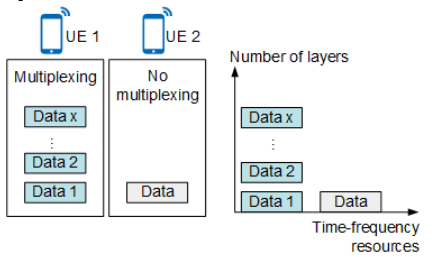5G-NR SU-MIMO (Single User MIMO) is a multi-antenna technique that implements spatial multiplexing of time-frequency resources for a single UE. It applies to PUSCH and PDSCH. It enables multi-layer data transmission, as shown below, and increases the single UE peak rate in both uplink and downlink. As the MIMO used in 4G networks, multiple antennas allow the UEs to receive and transmit different data in parallel.

So what is the big difference in SU-MIMO already used in LTE and SU-MIMO in 5G NR? The simple answer is “the beam width & Number of layers”. In LTE networks , it is wide beams propagate in entire angle of the sector. But in 5G NR, beams are narrow (Massive MIMO using 64T64R antenna array).
Uplink 5G-NR SU-MIMO
For low-frequency TDD cells working in at least 32R mode and high-frequency TDD cells, the maximum number of PUSCH multiplexing layers for a single UE is equal to the minimum among the number of gNodeB RX antennas, the number of UE TX antennas, and the parameter configuration for Uplink Maximum MIMO Layer in the gNB equipment.
For other cells, the maximum number of PUSCH multiplexing layers for a single UE is equal to the minimum between:
- The number of gNodeB RX antennas
- The number of UE TX antennas
| gNodeB RX Antenna Number | UE TX Antenna Number | Maximum Number of PUSCH SU-MIMO Layers |
|---|---|---|
| 8R | 2T | 2 |
| 4R | 2T | 2 |
| 2R | 2T | 2 |
Downlink 5G-NR SU-MIMO
For low-frequency TDD cells working in at least 32T mode and high-frequency TDD cells, the maximum number of PDSCH multiplexing layers for a single UE is equal to the minimum among the gNodeB TX antennas, the number of UE RX antennas, and the parameter configuration for Downling Maximum MIMO Layer in the gNB equipment.
For other cells, the maximum number of PDSCH multiplexing layers for a single UE is equal to the minimum between the number of gNodeB TX antennas and the number of UE RX antennas, as shown below.
| gNodeB TX Antenna Number | UE RX Antenna Number | Maximum Number of PDSCH SU-MIMO Layers |
|---|---|---|
| 8T | 4R | 4 |
| 4T | 4R | 4 |
| 2T | 4R | 2 |
5G-NR SU-MIMO provides the following benefits:
- Uplink SU-MIMO
- If a UE supports uplink data transmission over N layers, its uplink peak rate is theoretically N times that of data transmission over a single layer.
- Downlink SU-MIMO
- If a UE supports downlink data transmission over N layers, its downlink peak rate is theoretically N times that of data transmission over a single layer.
Source: ![]()